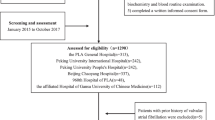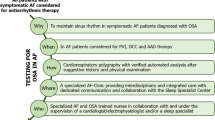Abstract
Background
Recurrent atrial fibrillation (AF) after successful cardioversion can be predicted by obstructive sleep apnea (OSA) diagnosed by polysomnography. However, it is not known whether the validated STOP-BANG questionnaire can predict AF recurrence after radiofrequency ablation (RFA). Our objective is to determine the prevalence of unrecognized OSA in patients with AF and its relation to freedom from AF after RFA.
Methods
Validated surveys were administered to 247 consecutive AF patients following radiofrequency ablation from January to October 2011. OSA status was assessed at baseline RFA. Clinical follow up occurred at 3-6 month intervals.
Results
OSA had been previously diagnosed in 94/247 (38%). Among 153 patients without prior diagnosis of OSA, 121 (79%) had high risk STOP-BANG scores for OSA. Probability of maintaining sinus rhythm after RFA was similar among patients with known OSA (66/94, 70%) and high risk OSA scores (95/124, 77%) and higher than among patients with low risk OSA scores (29/32, 91%, P=0.03). Among patients without prior OSA, a high risk STOP-BANG score did predict recurrent AF (OR = 3.7, 95 % CI 1.4–11.4, P = 0.0005). Multivariate analysis showed a higher risk of atrial arrhythmia recurrence for non-paroxysmal AF patients (OR = 3.1, ± 95 % CI 1.4–7.1, P = 0.005).
Conclusions
The majority of AF patients undergoing RFA have high risk OSA scores, suggesting that OSA is vastly underdiagnosed in this population. STOP-BANG independently predicted recurrent AF in patients without a prior diagnosis of OSA.

Similar content being viewed by others
References
Gami, A. S., Pressman, G., Caples, S. M., Kanagala, R., Gard, J. J., Davison, D. E., Malouf, J. F., Ammash, N. M., Friedman, P. A., & Somers, V. K. (2004). Association of atrial fibrillation and obstructive sleep apnea. Circulation, 110, 364–367.
Ng, C. Y., Liu, T., Shehata, M., Stevens, S., Chugh, S. S., & Wang, X. (2011). Meta-analysis of obstructive sleep apnea as predictor of atrial fibrillation recurrence after catheter ablation. American Journal of Cardiology, 108, 47–51.
Young, T., Skatrud, J., & Peppard, P. E. (2004). Risk factors for obstructive sleep apnea in adults. JAMA, 291, 2013–2016.
Chung, F., Yegneswaran, B., Liao, P., Chung, S. A., Vairavanathan, S., Islam, S., Khajehdehi, A., & Shapiro, C. M. (2008). Stop questionnaire: a tool to screen patients for obstructive sleep apnea. Anesthesiology, 108, 812–821.
Kanagala, R., Murali, N. S., Friedman, P. A., Ammash, N. M., Gersh, B. J., Ballman, K. V., Shamsuzzaman, A. S., & Somers, V. K. (2003). Obstructive sleep apnea and the recurrence of atrial fibrillation. Circulation, 107, 2589–2594.
Hoyer, F. F., Lickfett, L. M., Mittmann-Braun, E., Ruland, C., Kreuz, J., Pabst, S., Schrickel, J., Juergens, U., Tasci, S., Nickenig, G., & Skowasch, D. (2010). High prevalence of obstructive sleep apnea in patients with resistant paroxysmal atrial fibrillation after pulmonary vein isolation. Journal of Interventional Cardiac Electrophysiology, 29, 37–41.
Johns, M. W. (1991). A new method for measuring daytime sleepiness: the Epworth Sleepiness Scale. Sleep, 14, 540–545.
Jongnarangsin, K., Chugh, A., Good, E., Mukerji, S., Dey, S., Crawford, T., Sarrazin, J. F., Kuhne, M., Chalfoun, N., Wells, D., Boonyapisit, W., Pelosi, F., Jr., Bogun, F., Morady, F., & Oral, H. (2008). Body mass index, obstructive sleep apnea, and outcomes of catheter ablation of atrial fibrillation. Journal of Cardiovascular Electrophysiology, 19, 668–672.
Jongnarangsin, K., Suwanagool, A., Chugh, A., Crawford, T., Good, E., Pelosi, F., Jr., Bogun, F., Oral, H., & Morady, F. (2012). Effect of catheter ablation on progression of paroxysmal atrial fibrillation. Journal of Cardiovascular Electrophysiology, 23, 9–14.
Somers, V. K., White, D. P., Amin, R., Abraham, W. T., Costa, F., Culebras, A., Daniels, S., Floras, J. S., Hunt, C. E., Olson, L. J., Pickering, T. G., Russell, R., Woo, M., & Young, T. (2008). Sleep apnea and cardiovascular disease: an American Heart Association/American College of Cardiology Foundation scientific statement from the American Heart Association Council for High Blood Pressure Research Professional Education Committee, Council on Clinical Cardiology, Stroke Council, and Council on Cardiovascular Nursing. In collaboration with the National Heart, Lung, and Blood Institute National Center on Sleep Disorders Research (National Institutes of Health). Circulation, 118, 1080–1111.
Somers, V. K., Dyken, M. E., Clary, M. P., & Abboud, F. M. (1995). Sympathetic neural mechanisms in obstructive sleep apnea. Journal of Clinical Investigation, 96, 1897–1904.
Bhargava, M., Di Biase, L., Mohanty, P., Prasad, S., Martin, D. O., Williams-Andrews, M., Wazni, O. M., Burkhardt, J. D., Cummings, J. E., Khaykin, Y., Verma, A., Hao, S., Beheiry, S., Hongo, R., Rossillo, A., Raviele, A., Bonso, A., Themistoclakis, S., Stewart, K., Saliba, W. I., Schweikert, R. A., & Natale, A. (2009). Impact of type of atrial fibrillation and repeat catheter ablation on long-term freedom from atrial fibrillation: results from a multicenter study. Heart Rhythm, 6, 1403–1412.
Shah, A. N., Mittal, S., Sichrovsky, T. C., Cotiga, D., Arshad, A., Maleki, K., Pierce, W. J., & Steinberg, J. S. (2008). Long-term outcome following successful pulmonary vein isolation: pattern and prediction of very late recurrence. Journal of Cardiovascular Electrophysiology, 19, 661–667.
Fein, A. S., Shvilkin, A., Shah, D., Haffajee, C. I., Das, S., Kumar, K., Kramer, D. B., Zimetbaum, P. J., Buxton, A. E., Josephson, M. E., & Anter, E. (2013). Treatment of obstructive sleep apnea reduces the risk of atrial fibrillation recurrence after catheter ablation. Journal of the American College of Cardiology, 62, 300–305.
Naruse, Y., Tada, H., Satoh, M., Yanagihara, M., Tsuneoka, H., Hirata, Y., Ito, Y., Kuroki, K., Machino, T., Yamasaki, H., Igarashi, M., Sekiguchi, Y., Sato, A., & Aonuma, K. (2013). Concomitant obstructive sleep apnea increases the recurrence of atrial fibrillation following radiofrequency catheter ablation of atrial fibrillation: clinical impact of continuous positive airway pressure therapy. Heart Rhythm, 10, 331–337.
Patel, D., Mohanty, P., Di Biase, L., Shaheen, M., Lewis, W. R., Quan, K., Cummings, J. E., Wang, P., Al-Ahmad, A., Venkatraman, P., Nashawati, E., Lakkireddy, D., Schweikert, R., Horton, R., Sanchez, J., Gallinghouse, J., Hao, S., Beheiry, S., Cardinal, D. S., Zagrodzky, J., Canby, R., Bailey, S., Burkhardt, J. D., & Natale, A. (2010). Safety and efficacy of pulmonary vein antral isolation in patients with obstructive sleep apnea: the impact of continuous positive airway pressure. Circulation. Arrhythmia and Electrophysiology, 3, 445–451.
Tang, R. B., Dong, J. Z., Liu, X. P., Kang, J. P., Ding, S. F., Wang, L., Long, D. Y., Yu, R. H., Liu, X. H., Liu, S., & Ma, C. S. (2009). Obstructive sleep apnoea risk profile and the risk of recurrence of atrial fibrillation after catheter ablation. Europace, 11, 100–105.
Chilukuri, K., Dalal, D., Marine, J. E., Scherr, D., Henrikson, C. A., Cheng, A., Nazarian, S., Spragg, D., Berger, R., & Calkins, H. (2009). Predictive value of obstructive sleep apnoea assessed by the Berlin questionnaire for outcomes after the catheter ablation of atrial fibrillation. Europace, 11, 896–901.
Netzer, N. C., Stoohs, R. A., Netzer, C. M., Clark, K., & Strohl, K. P. (1999). Using the Berlin questionnaire to identify patients at risk for the sleep apnea syndrome. Annals of Internal Medicine, 131, 485–491.
Matiello, M., Nadal, M., Tamborero, D., Berruezo, A., Montserrat, J., Embid, C., Rios, J., Villacastin, J., Brugada, J., & Mont, L. (2010). Low efficacy of atrial fibrillation ablation in severe obstructive sleep apnoea patients. Europace, 12, 1084–1089.
Disclosures
This work was supported in part by a MICHR Grant for support of clinical and translational research, UL1RR024986. The authors have no financial or other conflict of interest. The authors are solely responsible for the design and conduct of this study, all study analyses, the drafting and editing of the paper, and its final contents.
Author information
Authors and Affiliations
Corresponding author
Rights and permissions
About this article
Cite this article
Farrehi, P.M., O’Brien, L.M., Bas, H.D. et al. Occult obstructive sleep apnea and clinical outcomes of radiofrequency catheter ablation in patients with atrial fibrillation. J Interv Card Electrophysiol 43, 279–286 (2015). https://doi.org/10.1007/s10840-015-0014-4
Received:
Accepted:
Published:
Issue Date:
DOI: https://doi.org/10.1007/s10840-015-0014-4




